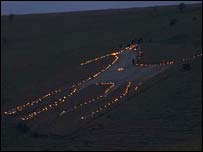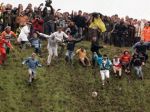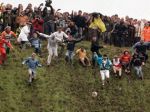Visiting my local Tescos supermarket on a busy Satuday morning often feels more like a Viking raid. Anyway heres one for our Danish friends…
They knelt and cowered together – a once proud and fearless band of raiders stripped and humiliated by their Saxon captors.
One by one, their executioners stepped forward, uttered a prayer and brought their axes and swords crashing down on the necks of the Viking prisoners.
The axes fell until the roadside was sticky with blood from the decapitated corpses of the 51 men, most barely in their twenties.
Enlarge 
Burial site: The decapitated skulls were left in one part of a pit and the bodies in another near Weymouth, Dorset, during excavations for a relief road

The 51 executed would have been a captured raiding party
Soon the excited crowd joined in, spearing a couple of heads on stakes, placing the rest in a neat pile and tossing the bodies into a ditch.
For more than 1,000 years this bloody roadside act was forgotten, one of many atrocities in the long and violent struggle between the Anglo-Saxons and the Norse invaders.
Now, thanks to an extraordinary piece of luck – and detective work – the massacre has been uncovered by archaeologists in a discovery that sheds fascinating new light on life in Viking Britain.
The 51 beheaded skeletons were discovered last summer near Weymouth, Dorset, during excavations for a relief road.
Over the following two months, Oxford Archaeology removed the skulls which had been placed together in one part of a pit, and the bodies which had been thrown roughly into a heap a few feet away.
A chemical analysis of teeth from ten of the men showed they grew up in countries where the climate is far colder than Britain – with one individual thought to have come from within the Arctic Circle.
Carbon dating showed they were buried between 910 and 1030AD, a time when England was being unified under Saxon kings and when Vikings from Denmark had begun a second wave of raids on the South Coast.
Oxford Archaeology project manager David Score said: ‘To find out that the young men executed were Vikings is a thrilling development.
‘Any mass grave is a relatively rare find, but to find one on this scale, from this period of history, is extremely unusual.’
For researchers, there is no question that the victims were Vikings. And not the Vikings who had settled and lived in Britain for generations, but almost certainly a captured raiding party.
In the heart of Anglo-Saxon Wessex – the stronghold of Alfred the Great and his descendants – justice against rogue Vikings would have been violent and swift.
The blows to the back of their necks were so fierce that the swords cut into the jaws and collarbones.
One man had wounds to his hands – indicating that he grabbed for the blade in a futile bid to save himself. Others suffered blows to pelvis, stomach and chest.
There were more bodies than skulls, leading to speculation that three dismembered heads were displayed on stakes.
Oxford archaeology bone specialist Ceri Boston said: ‘It was not a straight one slice and head off. They were all hacked at around the head and jaw. It doesn’t look like they were very willing or the executioners very skilled.
‘We think the decapitation was messy because the person would have been moving around.
‘The location is a typical place for a Saxon execution site – on a main road and a parish boundary and close to prehistoric barrows.’
Enlarge 
A researcher sifts through the Viking bones found by the side of the road
Enlarge 
The first waves of Vikings to arrive were after loot – and they saw the undefended monasteries, with their silver chalices and gold crosses as a soft target

Osteologist Helen Webb from Oxford Archaeology with one of the skull fragments
Although a raiding party seems the most likely explanation, the men could have been caught in battle some distance away and taken to Weymouth for execution. Or they could even have been killed by a rival Viking party.
History suggests that the Viking raiders could be just as ruthless as their fearsome reputation.
The first to arrive in Britain were after loot – and they saw the undefended monasteries, with their silver-chalices, gold crosses and bejewelled books, as a soft target.
The raids – which started in Lindisfarne in Northumbria in 793AD, then one of Europe’s most holy sites – sent shockwaves through the country and signalled an era of terror that would last, on and off, for more than 200 years.
In 865AD a full army arrived to storm through Britain, taking three of the kingdoms of England – Northumbria, East Anglia and Mercia – before finally attacking the remaining Anglo-Saxon stronghold of Wessex.
There, under the leadership of King Alfred, the Saxons organised themselves and pushed back – eventually dividing Britain into Wessex to the West and Danelaw to the East. By the time of the Weymouth massacre, the Saxons had regained most of their old territories and had created the first unified English kingdom.
But the birth of England was accompanied by a return of the Viking raiders, spurred on by Danish royalty back home.
Some involved a couple of boats and a few dozen men, but others involved 100 boats.
The raids ended in 1016, when the throne was taken by the Danish King Canute.
Life in Viking times would have been tough and short.
Dr Richard Hall, director of archaeology at the York Archaeological Trust, said: ‘Vikings would be the same build and height as us.
‘But there would be few women over 35 because so many died in childbirth. And if you lived to 50 you were doing very well.’
Vikings – and the Saxons that some came to live alongside – were riddled with parasites.
Worms, fleas and lice were common and Vikings kept their hair meticulously groomed to remove the steady supply of nits and fleas.
Water was rarely safe to drink in the ninth and tenth centuries, and Vikings would drink weak beer, or imported wine if they were wealthy enough. Mead made with honey was also popular.
Those who settled in Britain lived in wooden long houses, with thick walls to keep them cool in summer and warm in winter.
Families slept together in the centre of the hall around a fire pit.
They ate bread, cottage cheese, milk and cured meats and fish, supplementing their diet with wild fruits, honey and nuts.
Their bowls and plates were similar to our own but they ate with a sharp-pointed knife which doubled up as a fork.
Drink was taken in horns, while spoons were often ornately carved.
The Viking raids on monasteries created the impression to many Saxons that they hated Christianity. But in reality Vikings who settled in Britain adopted the native religion very easily.
Those who did not convert worshipped a pantheon of charismatic gods.
Their most powerful was the one-eyed Odin, but the most popular was Thor – a stupid but strong god who throws lightning bolts.
Despite the popular image of legend, there is no evidence that Vikings wore horned helmets.
The myth came from the discovery of ceremonial helmets in Scandinavia.
Read more: http://www.dailymail.co.uk/sciencetech/article-1257333/Decapitated-Viking-skeletons-Weymouth-ditch.html#ixzz0iEpL7Oar
Nicholas – Stonehenge Tour Guide
HISTOURIES UK – The Best Tours in British History
Read Full Post »

 and up to date answer:
and up to date answer: The implication is that layers of paving and sediment were laid over the Period 4 (see table) surface in a fairly swift succession. The subsequent re-pavings were all of rubble and dumped tile. There were also traces of small structures being built against the north wall of the spring reservoir. It seems that what had been built as a great architectural monument in the 2nd or 3rd century was being remodelled much more simply from whatever materials were to hand in the late 4th.
The implication is that layers of paving and sediment were laid over the Period 4 (see table) surface in a fairly swift succession. The subsequent re-pavings were all of rubble and dumped tile. There were also traces of small structures being built against the north wall of the spring reservoir. It seems that what had been built as a great architectural monument in the 2nd or 3rd century was being remodelled much more simply from whatever materials were to hand in the late 4th. The demolition of the temple and baths should be seen in the same light as the construction of refortified hillforts: a community mobilised the resources and labour necessary to remove a major set of structures from the ancient Roman townscape, just as they did to create new high-order settlements in the surrounding countryside. Gildas hints at why they might have done this. Writing in the early 6th century, he rages against British kings for their sins: they were murderers and usurpers. But not once does he call them ‘pagans’.
The demolition of the temple and baths should be seen in the same light as the construction of refortified hillforts: a community mobilised the resources and labour necessary to remove a major set of structures from the ancient Roman townscape, just as they did to create new high-order settlements in the surrounding countryside. Gildas hints at why they might have done this. Writing in the early 6th century, he rages against British kings for their sins: they were murderers and usurpers. But not once does he call them ‘pagans’.




 The 51 executed would have been a captured raiding party
The 51 executed would have been a captured raiding party



 Osteologist Helen Webb from Oxford Archaeology with one of the skull fragments
Osteologist Helen Webb from Oxford Archaeology with one of the skull fragments


